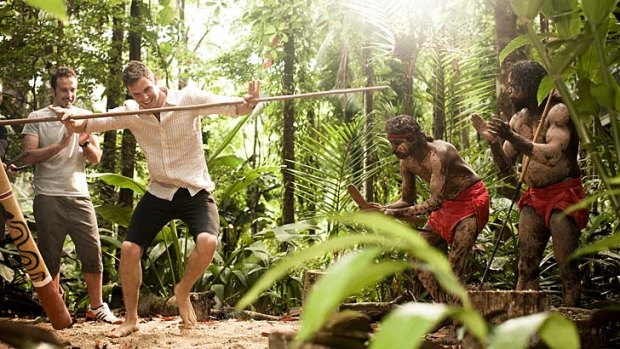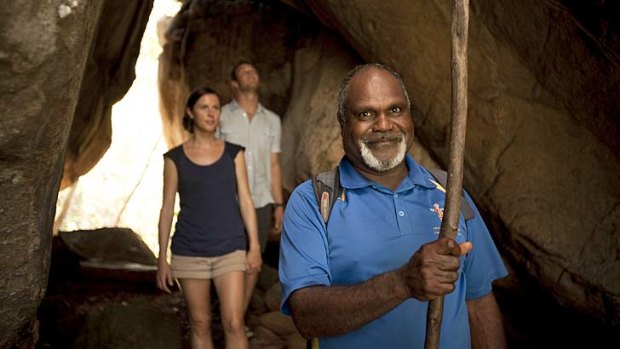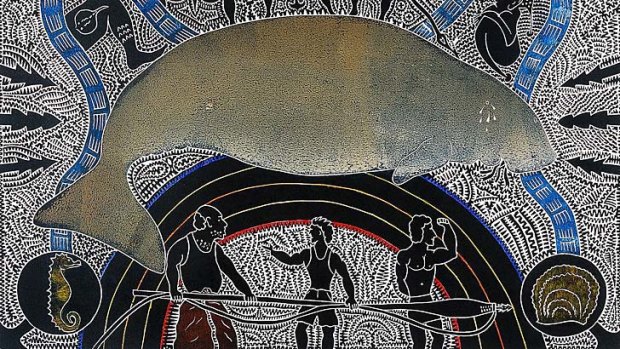
Spiritual life... travellers discover indigenous history on a Bama Way tour.
Lance Richardson tours the Bama Way 'song lines' between Cairns and Cooktown, en route to the region's annual art fair.
'My name is Billy Missi," the man says, leaning over a linocut print showing the traditional way of hunting for dugongs. "I am one of the founding members of the first-ever printmaking facility established in the outer Torres Strait Islands." He directs my attention around the intricate print, unpacking its symbolism, how the hunters work in harmony with the tide and the phases of the moon.
Then he talks about his ancestors: "I come from a line of people who are accurate with their predictions." A book is opened and another linocut revealed, one he prepared more than 10 years earlier. At the centre of Dhangal Um Araik is an enormous dugong, sand-coloured and weeping. "It's about the past, the present and beyond," Missi says. Above the animal are traditional hunters, an echo of the past; around it are pointed spears, a depiction of the present; below it, with a black rainbow representing "beyond", are members of the new and coming generations, searching for something no longer there.

Elder Willie Gordon guides visitors through his ancestral country.
It is nothing new in saying indigenous art is inseparable from storytelling. What is newly apparent to a growing audience is experimentation in different mediums and an expansion of scope and intention on the part of the artists.
I visit Missi in Canopy Artspace in Cairns, where students have come to learn from him and Alick Tipoti, the first Torres Strait Islander to feature in the Biennale of Sydney. Lining the walls, Tipoti's enormous ceremonial masks - feathered, beaded and carefully carved - are made from fibreglass. Before these he worked in linocut.
Missi says he makes art "so people can accept our surroundings and we can move forward as modern Australians". Notably, the audience for this is no longer strictly indigenous.

Billy Missi's Dhangal Um Araik linocut.
In many ways, Missi and Tipoti exemplify the governing spirit of the Cairns Indigenous Art Fair, held on August 17-19. Described by its organisers as an "ethical art fair", it gives Queensland artists - some living in remote places - an opportunity to share their work with a large audience of collectors, curators, other artists and people with a general interest in indigenous culture. The co-patron of the event, Henrietta Marrie, calls it an opportunity "to come together and debate and work out issues, and talk about how indigenous art contributes to our economy".
In the past three years more than 33,500 people have visited the annual fair. The sale of works has generated about $1.8 million, all of which has gone directly to the artists and the art centres that supported them. "What we're trying to do is show that Queensland artists have been batting pretty high," the artistic director, Avril Quaill, tells me.
More commonly associated with backpackers and dive charters, Cairns might seem an unusual location to do this, but the fair is about upending preconceptions as well. It will be launched by a musical performance sung in indigenous language by the Briscoe Sisters and the Torres Strait Islands Choir - a collaborative first between different cultural groups. The schedule is rounded out by workshops, dance, sculpture and performance art exhibitions curated by Quaill at the Cairns Regional Gallery; even a symposium questioning the future of Indigenous art in Australia. Much of this indigenous culture can be accessed all year; some of it, such as the newly opened Mossman Gorge Centre - an eco-tourism development at the World Heritage site, featuring Aboriginal art - is an easy drive from Cairns. "It's always about storytelling," an art co-ordinator at the centre, Sheryl Burchill, says. "It's about getting our culture across to other people: our families, the fruits we collect, the foods we eat. Just stories."
The Bama Way Discovery Tour, a journey along "story lines" in south-east Cape York, removes even the need to drive. It is the combined effort of Adventure North, an Aboriginal tour specialist, and several traditional land custodians based from Cairns to Cooktown, focusing on the Kuku Yalanji and Guugu Yimithirr language groups.
A traveller on the Bama Way follows a trail that resembles a rainbow serpent on the map, snaking past Cape Tribulation to the tropical heights of far north Queensland, crossing mangroves and the Daintree Rainforest with an Adventure North driver guide. At Janbal Gallery near Mossman, Brian "Binna" Swindley shares his artistic skills; at Wujal Wujal ("so nice you say it twice"), we stop at the Bana Yiriji Arts and Cultural Centre, where locals express themselves in a large workshop and sell their stories to visitors. It is this sort of facility, replicated all over Queensland, that supplies the Cairns Indigenous Art Fair with material.
Taken in full, the Bama Way encompasses several distinct tours that can also be taken individually. "We do this every day," Linc Walker says, as he wades knee-deep through a mangrove swamp off Cooya Beach, spear at the ready. "We just decided to bring visitors along with us."
His Kuku Yalanji Cultural Habitat Tour, co-managed with his brother, Brandon, offers first-hand experience of traditional fishing techniques. We stalk the low tide, searching for periwinkles, mussels, mud welts and crabs. Then, over a feast fashioned from the day's catch, he shares his family tree, assembled as a mosaic of small photographs. "A lot of this is for our children, too," Walker says, meaning everything from the spears and beach almonds to the strangers sitting on his porch, learning about the ways of his ancestors.
Guurrbi Tours, based north of Cooktown, finishes the Bama Way with a fascinating turn to rock art. A soft-spoken Nugal-warra elder, Willie Gordon, leads us deep into the bush by Hope Vale, expounding on everything from birds to economics. Sometimes he balances a stick on his hands - a suggestion we are unbalanced in life because we do not pay attention to our surroundings. There is a disarming dose of irony thrown in for good measure: "The church told us our beliefs were bad," he says, ducking under a sandstone overhang to find the paintings beneath. "But if we lived with them for 40,000 years, they can't be that bad. If [the church] want to argue with me I'll call Richard Dawkins."
After looking at a birthing rock, where babies with umbilical cords are etched in ochre and a father is upside down "because he doesn't know what to do", I ask Gordon what he thinks about the fair in Cairns and the future of indigenous art. We settle down in a cave covered with stencils of goannas and handprints, the rainbow serpent writhing overhead in white.
"As long as the stories are there the patterns don't matter," Gordon says. The important things in art are flexibility and the ability to change mediums. Indeed, too many people equate authenticity with age when approaching Aboriginal art. When it comes to the Cairns Indigenous Art Fair, "you have to go there with an open mind", Gordon says. "You carry the authenticity forward in the story."
Lance Richardson travelled courtesy of Tourism Queensland.
FAST FACTS
Getting there
Virgin Australia, Jetstar and Qantas fly daily non-stop to Cairns from Sydney and Melbourne. Tiger Airways flies non-stop from Melbourne only.
Staying there
The Pullman Reef Hotel Casino has well-appointed rooms close to the site of the Art Fair in Cairns. An on-site restaurant, Tamarind, is a standout. Rooms cost from $199 a night; see reefcasino.com.au.
The remote Bloomfield Lodge, built in rainforest near the Coral Sea, is reached by boat and seaplane. Four-night packages cost from $1520 a person, twin share, and include food, accommodation and return flights from Cairns; see bloomfieldlodge.com.au.
Silky Oaks Lodge in the Daintree Rainforest, a short drive from Mossman Gorge, is luxury accommodation on the north bank of Mossman River. Rooms cost from $548 a night; see silkyoakslodge.com.au.
While there
The Cairns Indigenous Art Fair is on August 17-19 in the Cairns Cruise Liner Terminal and at selected city sites. An accompanying exhibition runs in the Cairns Regional Gallery until October; see ciaf.com.au.
The Bama Way is a partnership between Adventure North and three indigenous-owned tour operators. Guided itineraries range from one to three days, leaving from Cairns or Port Douglas. Each tour can also be taken individually. A three-day Discovery Tour costs from $1169 a person, twin share, and includes meals, transport and accommodation. Phone (07) 4040 7500; see bamaway.com.au.
Shuttle bus access from Cairns to Mossman Gorge costs $4.80 return. Local Aboriginal art and guided indigenous Dreamtime walks cost from $45 a person; see mossmangorge.com.au.
More information
Sign up for the Traveller Deals newsletter
Get exclusive travel deals delivered straight to your inbox. Sign up now.